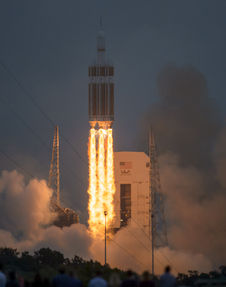
© NASA/Bill Ingalls
NASA's successful
test flight of Orion on Dec. 5th heralds a renewed capability to send astronauts into deep space. A paper just published in the journal
Space Weather, however, points out a growing peril to future deep space explorers: cosmic rays.
The title of the article, penned by Nathan Schwadron of the University of New Hampshire and colleagues from seven other institutions, asks the provocative question, "Does the worsening galactic cosmic ray environment preclude manned deep space exploration?" Using data from a cosmic ray telescope on board NASA's Lunar Reconnaissance Orbiter, they conclude that while
increasing fluxes of cosmic rays "are not a show stopper for long duration missions (e.g., to the Moon, an asteroid, or Mars), galactic cosmic radiation remains a significant and worsening factor that
limits mission durations." This figure from their paper shows the number of days a 30 year old astronaut can spend in interplanetary space before they reach their career limit in radiation exposure:
According to the plot, in the year 2014, a 30 year old male flying in a spaceship with 10 g/cm
2 of aluminum shielding could spend approximately 700 days in deep space before they reach their radiation dose limit. The same astronaut in the early 1990s could have spent 1000 days in space.
What's going on?
Cosmic rays are intensifying. Galactic cosmic rays are a mixture of high-energy photons and subatomic particles accelerated to near-light speed by violent events such as supernova explosions. Astronauts are protected from cosmic rays in part by the sun: solar magnetic fields and the solar wind combine to create a porous 'shield' that fends off energetic particles from outside the solar system. The problem is, as the authors note, "The sun and its solar wind are currently exhibiting extremely low densities and magnetic field strengths, representing states that have never been observed during the Space Age. As a result of the remarkably weak solar activity, we have also observed the highest fluxes of cosmic rays in the Space Age."
The shielding action of the sun is strongest during solar maximum and weakest during solar minimum--hence the 11-year rhythm of the mission duration plot. At the moment we are experiencing Solar Max, which should be a good time for astronauts to fly--but it's not a good time. The solar maximum of 2011-2014 is the
weakest in a century, allowing unusual numbers of cosmic rays to penetrate the solar system.
This situation could become even worse if, as some researchers suspect, the sun is entering a long-term phase of the solar cycle characterized by relatively weak
maxima and deep, extended
minima. In such a future, feeble solar magnetic fields would do an extra-poor job keeping cosmic rays at bay, further reducing the number of days astronauts can travel far from Earth.
To learn more about this interesting research, read
the complete article in the online edition of
Space Weather.
Any trip to Mars or beyond will require shielding. Plain and simple. Any colony on Mars MUST have shielding or it will be a single generation colony.